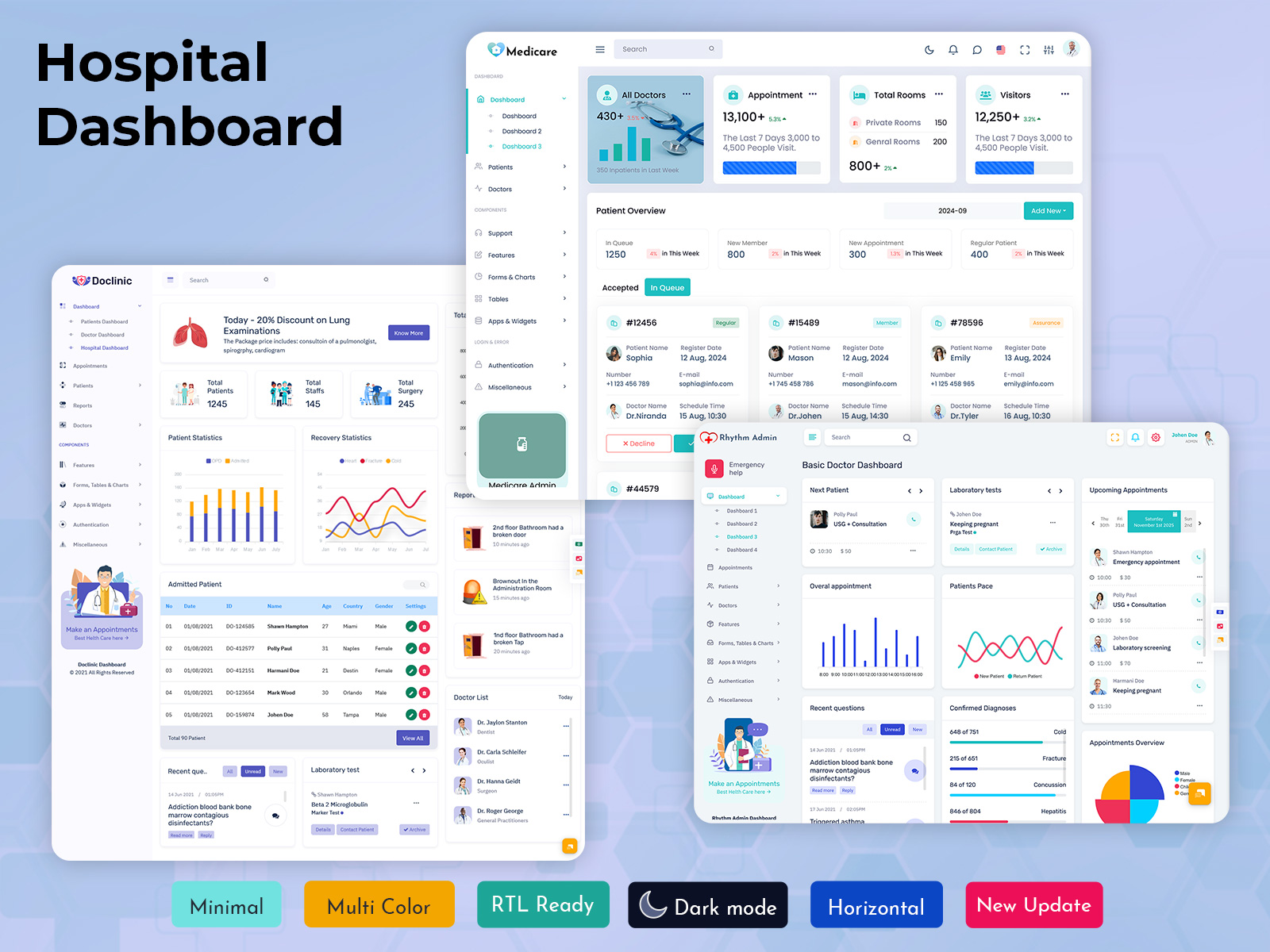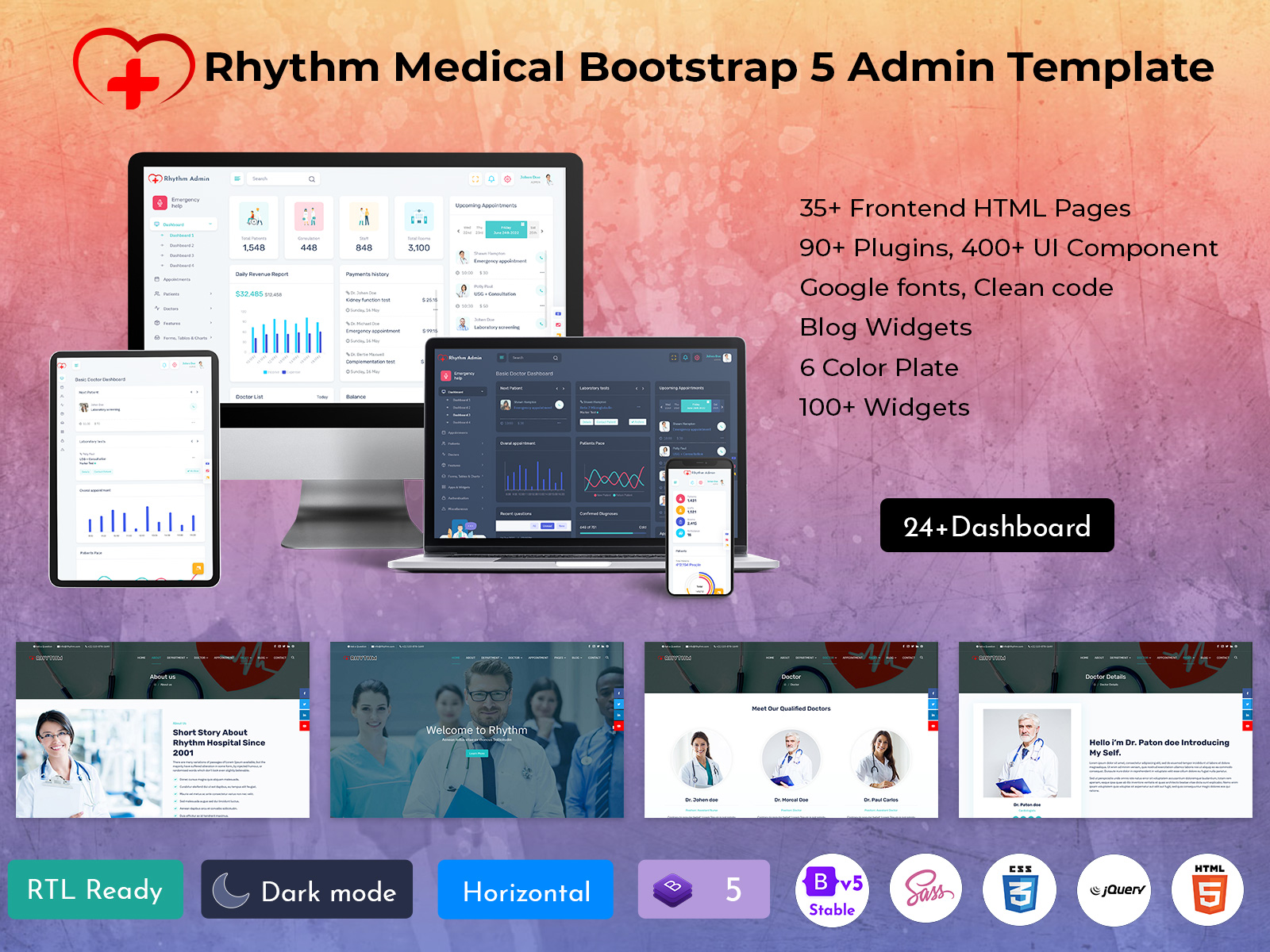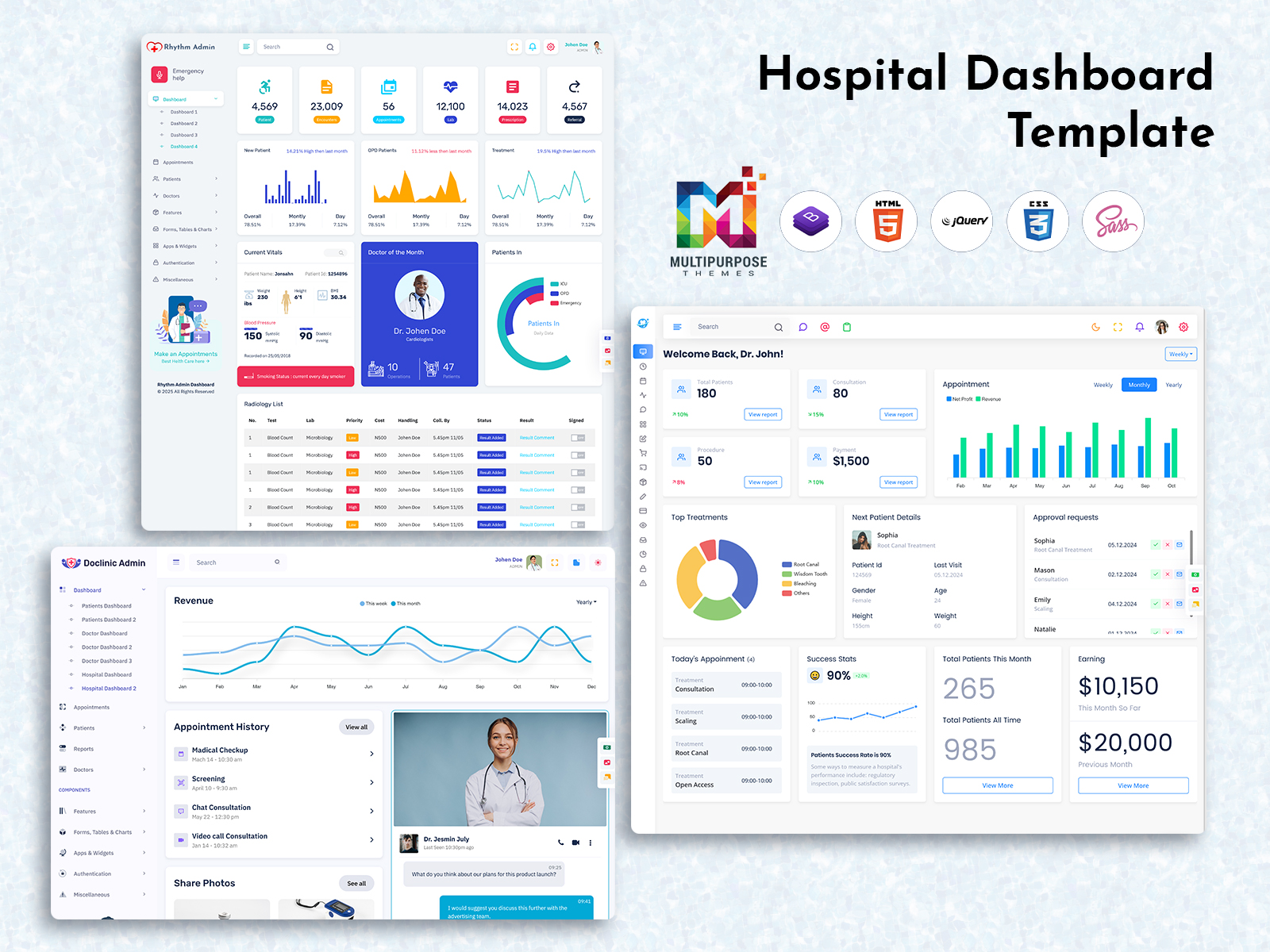A hospital dashboard brings all your important health data together in one place. Think of…

5 Key Lessons for Creating Effective Hospital Dashboard
Reading Time: 5 minutes
Imagine working in a hospital where doctors, nurses, and administrators are buried in piles of reports. Important information is scattered all over, making it hard to make quick decisions. Patient care gets delayed, the hospital becomes inefficient, and costs spiral out of control. This is where a Hospital Dashboard can make all the difference. It streamlines operations, helps in better decision-making, and ultimately improves patient care and hospital efficiency. In this article, we will discuss the five key lessons for creating an effective Hospital Dashboard.
Explore Our Smart Hospital Dashboards
Oral Admin – Dentist Dashboard
BUY NOW DEMO
Rhythm Admin – Healthcare Dashboard
BUY NOW DEMO
Doclinic Admin – Patients Dashboard
BUY NOW DEMO
Medicare Admin – Medical Dashboard
BUY NOW DEMO
Bsinx Admin – Hospital Dashboard
BUY NOW DEMO
Gilded Admin – Doctor Dashboard
BUY NOW DEMO
Tresto Admin – Clinic Dashboard
BUY NOW DEMO
Lesson 1: Define Clear Objectives and Key Performance Indicators (KPIs)
A well-designed Hospital Dashboard isn’t just a collection of random data points. It must align with your hospital’s goals, helping you achieve the outcomes that matter most. Defining clear objectives and selecting relevant KPIs is essential for a successful dashboard.
Understanding Hospital Objectives
Before you create a Medical Dashboard, you must define what your hospital aims to achieve. Common objectives for healthcare institutions include improving patient outcomes, enhancing patient satisfaction, reducing costs, and managing resources more efficiently. A Hospital Admin Dashboard should track metrics that align with these objectives.
Selecting Relevant KPIs
To measure progress towards your hospital’s goals, you need to pick KPIs that matter. For example, patient readmission rates are a key KPI for hospitals focused on improving care quality. Other important KPIs include:
– Patient satisfaction scores (HCAHPS)
– Average length of stay
– Occupancy rates
– Infection rates
– Surgical success rates
– Supply costs
These metrics give both hospital administrators and staff the insights they need to make informed decisions. Be sure to align the Hospital Dashboard Template with the specific needs of different stakeholders. For instance, a Doctor Dashboard might emphasize surgical outcomes, while a Nurse Dashboard might focus on medication errors and patient satisfaction.
Lesson 2: Prioritize Data Quality and Accuracy
A Hospital Dashboard is only as good as the data it displays. If your data is unreliable or inaccurate, it could lead to poor decision-making. Data quality is paramount in healthcare, where the stakes are high.
Establishing Data Governance Policies
To ensure good data quality, establish data governance policies. This means defining roles and responsibilities for data collection, validation, and maintenance. It’s important to decide who is responsible for verifying data and ensuring its accuracy. A reliable Medical Admin Template will also provide tools for monitoring the accuracy of the data in real-time.
Implementing Data Validation Processes
Data validation processes are crucial for maintaining data quality. This involves steps like cleaning data to remove errors, profiling data to understand its structure, and reconciling data from different sources. For instance, patient information from multiple departments must be aligned to avoid discrepancies. A Medical Dashboard Template should include built-in validation tools to ensure the data remains accurate.
Monitoring Data Integrity
Monitoring the integrity of data is an ongoing task. Once you have clean data, you need to continuously check for errors or inconsistencies. Implement automated systems to catch potential data issues early. This ensures that the information shown on your Patient Dashboard or Doctor Dashboard is always accurate and up to date.
Lesson 3: Design for Usability and Clarity
While it’s important to gather and present data, it’s equally essential to ensure that users can easily understand and navigate the Hospital Dashboard. A confusing, cluttered dashboard can overwhelm users and reduce its effectiveness.
Choosing the Right Visualizations
The way data is presented on a Hospital Dashboard is crucial. Different types of data require different kinds of visualizations. Bar charts, pie charts, line graphs, and scatter plots all serve distinct purposes. For example:
– Bar charts are great for comparing values across categories (like patient satisfaction across departments).
– Line charts are perfect for showing trends over time (such as the rate of infection over the past year).
– Pie charts can be used to display proportions (like the breakdown of patient conditions).
– Scatter plots reveal relationships between variables (like the correlation between patient age and length of stay).
Choosing the right visualization makes it easier for hospital staff to interpret the data at a glance, improving decision-making.
Simplifying Information Overload
It’s easy to get carried away with too much data, but too much information can confuse users. A Bootstrap 5 Admin Template or Bootstrap 5 Dashboard Template should include features like filters and drill-down options. This allows users to focus on the most important data while offering the ability to explore more detailed information if needed. Additionally, color-coding key metrics and reducing clutter can help highlight what matters most.
Optimizing Dashboard Layout and Navigation
The layout of the dashboard should be intuitive. The most important data should be prominently displayed, with clear navigation options to access other sections of the dashboard. For example, a Patient Dashboard Template should prioritize patient care information, while financial data might be tucked into a secondary section. A mobile-friendly design is also essential, especially in a hospital setting where staff are frequently on the move.
Lesson 4: Ensure Data Security and Compliance
In healthcare, protecting patient data is a legal and ethical responsibility. Compliance with regulations like HIPAA is essential for any Medical Dashboard. If your Doctor Dashboard Template or Patient Dashboard contains sensitive information, it must be secure.
Implementing Access Controls
Different users within the hospital require different levels of access to the data. For example, doctors should have access to patient health records, but administrative staff should not. Access controls allow you to restrict which users can view specific types of data. Make sure that the Medical Admin Template includes user authentication features, such as multi-factor authentication, to prevent unauthorized access.
Protecting Patient Health Information (PHI)
Patient health information (PHI) is highly sensitive. To comply with HIPAA and other privacy regulations, the Hospital Dashboard must incorporate features that protect this data. De-identification and anonymization techniques can be used to ensure that patient information is protected when it’s being analyzed or displayed.
Monitoring for Security Breaches
In addition to data encryption and access control, hospitals must monitor their systems for potential security breaches. The Hospital Admin Dashboard should include features for real-time security monitoring, allowing IT staff to respond quickly to any suspicious activity. Regular audits and updates to security protocols will help ensure the ongoing safety of patient data.
Lesson 5: Iterate and Improve Based on Feedback
A Hospital Dashboard is never truly finished. It must evolve to meet the changing needs of hospital staff and adapt to new technologies. Regular feedback from users is essential for continuous improvement.
Gathering User Feedback
Gathering feedback from different stakeholders is crucial. Use surveys, interviews, and usability testing to understand how well the Hospital Dashboard is serving its users. For example, doctors might suggest improvements in the way patient records are displayed, while administrators might request additional financial reports.
Analyzing Dashboard Usage Patterns
Tracking how users interact with the dashboard can provide valuable insights. Which sections of the dashboard are used most often? Are there areas that are underutilized? Analytics can help identify which features are most valuable and which ones need refinement.
Implementing Updates and Enhancements
Once you’ve gathered feedback and identified areas for improvement, it’s time to implement changes. Use agile development methods to quickly update the Medical Dashboard Template based on user feedback. This will keep the dashboard effective and relevant, allowing hospital staff to perform their tasks efficiently.
Conclusion
Creating an effective Hospital Dashboard is crucial for improving healthcare management. By defining clear objectives and selecting the right KPIs, prioritizing data quality, designing for usability, ensuring data security, and iterating based on feedback, hospitals can build dashboards that improve operational efficiency, patient care, and decision-making.
Using a Bootstrap Admin HTML or Bootstrap 5 Dashboard Template allows you to design a modern, responsive dashboard that meets the needs of both medical staff and administrators. With careful planning and continuous improvement, your Hospital Dashboard will provide a user-friendly interface for managing hospital operations, improving patient outcomes, and ensuring that your hospital stays compliant with regulations.
Start applying these lessons today to create a more efficient, data-driven hospital that puts patient care and operational efficiency first.
Buy Now and Get Started Today!
Click below to purchase and start unlocking the full potential of your business!
 skip to Main Content
skip to Main Content




This Post Has 0 Comments